Debugging Standalone Applications with the Vitis Debugger¶
This chapter describes debug possibilities with the design flow you have already been working with. The first option is debugging with software using the Vitis™ debugger.
The Vitis debugger provides the following debug capabilities:
Debugging of programs on Arm® Cortex™-A53, Arm® Cortex™-R5F, and MicroBlaze™ processor architectures (heterogeneous multi-processor hardware system debugging)
Debugging of programs on hardware boards
Debugging on remote hardware systems
A feature-rich IDE to debug programs
A Tool Command Language (Tcl) interface for running test scripts and automation
The Vitis debugger enables you to see what is happening to a program while it executes. You can set breakpoints or watchpoints to stop the processor, step through program execution, view the program variables and stack, and view the contents of the memory in the system.
The Vitis debugger supports debugging through Xilinx® System Debugger.
Xilinx System Debugger¶
The Xilinx System Debugger uses the Xilinx hardware server as the underlying debug engine. The Vitis IDE translates each user interface action into a sequence of Target Communication Framework (TCF) commands. It then processes the output from System Debugger to display the current state of the program being debugged. It communicates to the processor on the hardware using Xilinx hardware server.
The debug workflow is described in the following figure.
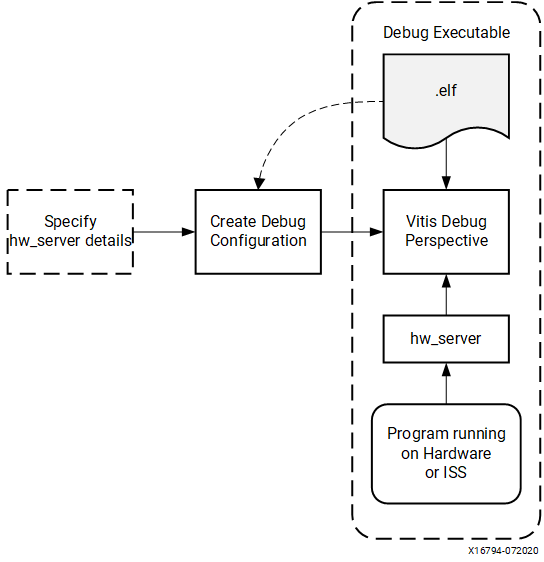
The workflow is made up of the following components:
Executable ELF File: To debug your application, you must use an executable and linkable format (ELF) file compiled for debugging. The debug ELF file contains additional debug information for the debugger to make direct associations between the source code and the binaries generated from that original source. To manage the build configurations, right-click the software application and select Build Configurations → Manage.
Debug Configuration: To launch the debug session, you must create a debug configuration in the Vitis debugger. This configuration captures the options required to start a debug session, including the executable name, processor target to debug, and other information. To create a debug configuration, right-click your software application and select Debug As → Debug Configurations.
Vitis Debug Perspective: Using the Debug perspective, you can manage the debugging or running of a program in the workbench. You can control the execution of your program by setting breakpoints, suspending launched programs, stepping through your code, and examining the contents of variables. To view the Debug Perspective, select Window → Open Perspective → Debug.
You can repeat the cycle of modifying the code, building the executable, and debugging the program in the Vitis debugger.
Note: If you edit the source after compiling, the line numbering will be out of step because the debug information is tied directly to the source. Similarly, debugging optimized binaries can also cause unexpected jumps in the execution trace.
Example 6: Debugging Software Using the Vitis Debugger¶
In this example, you will walk through debugging a “Hello World” application.
Note: If you did not create a “Hello World” application on the APU or RPU, follow the steps in Create Custom Bare-Metal Application for Arm Cortex-A53 based APU to create a new “Hello World” application.
After you create the “Hello World” application, work through the following example to debug the software using the Vitis debugger.
Connect the JTAG cable, set the boot mode to JTAG, and power on the board. Refer to the steps in Example 3: Running the “Hello World” Application from Arm Cortex-A53.
In the C/C++ Perspective, right-click the hello_a53 Project and select Debug As→ Launch on Hardware → Single Application Debug.
Note: The above step launches the Application Debugger in the Debug perspective based on the project settings. Alternatively, you can create a debug configuration which looks like the following figure.
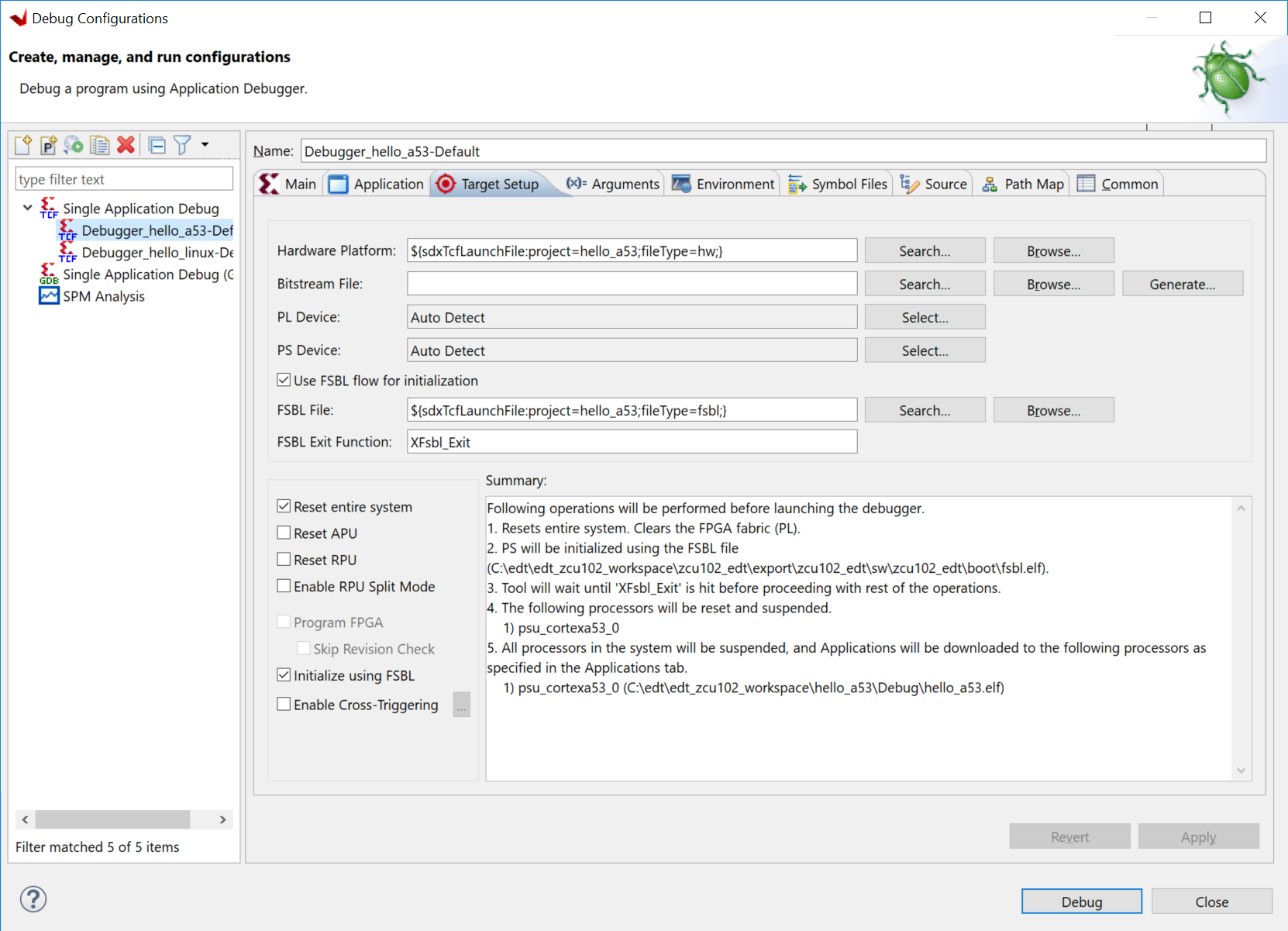
Note: The contents of Debug Configurations are identical to those in Run Configurations. The difference between run and debug is that debug stops at the
main()function by default.If the Confirm Perspective Switch popup window appears, click Yes. The Debug perspective opens.
Note: If the Debug perspective window does not open automatically, select Window→ Perspective → Open Perspective → Other, then select Debug in the Open Perspective wizard. You can quickly switch between Design Perspective and Debug Perspective with buttons on upper right corner.

The Debug Perspective looks like this:
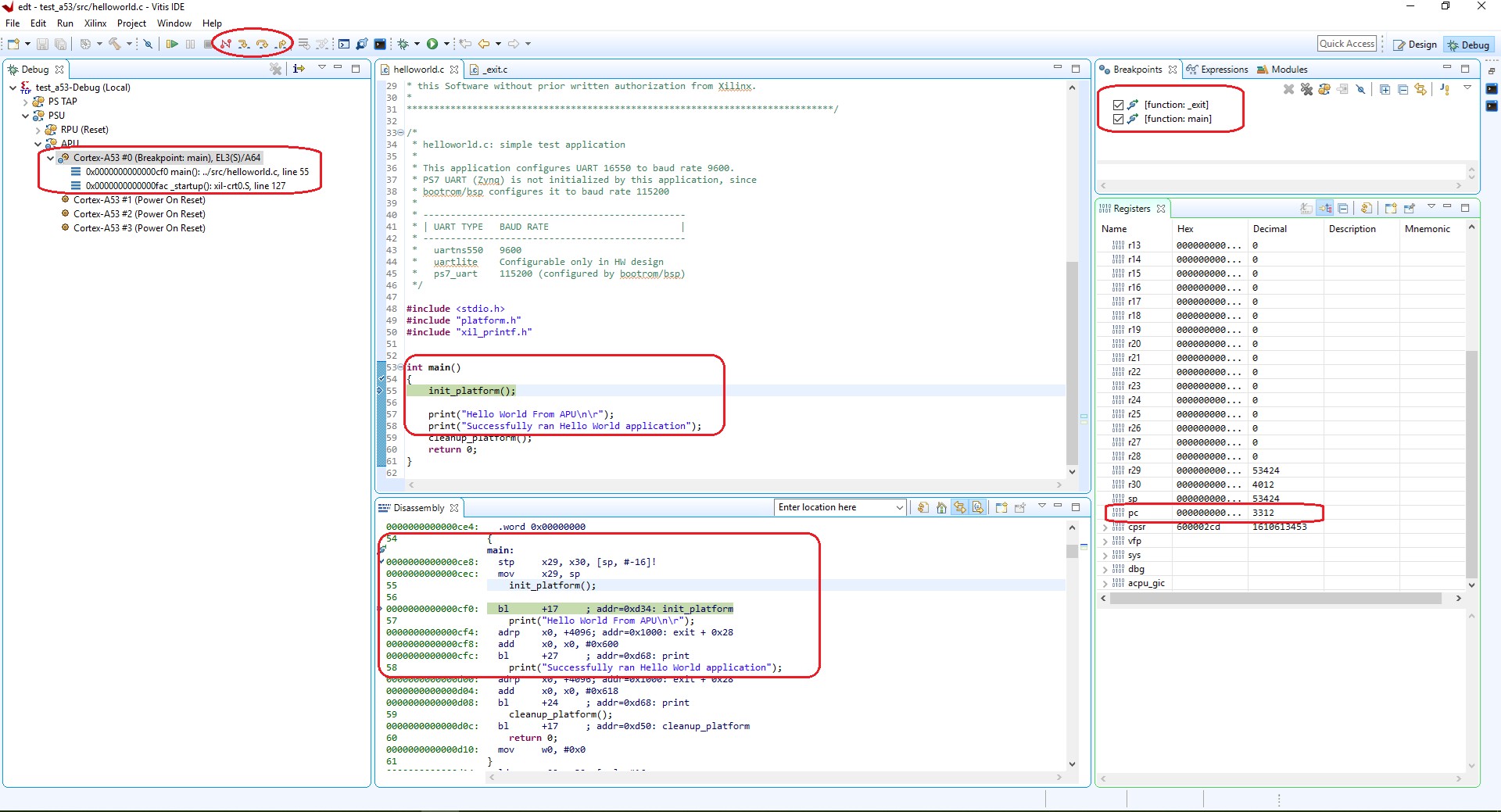
Note: The addresses shown on this page might slightly differ from the addresses shown on your system.
The processor is currently sitting at the beginning of
main()with program execution suspended at line0000000000000cf0. You can confirm this information in the Disassembly view, which shows the assembly-level program execution also suspended at0000000000000cf0.Note: If the Disassembly view is not visible, select Window→ Show View→ Disassembly.
The helloworld.c window also shows execution suspended at the first executable line of C code. Select the Registers view to confirm that the program counter, pc register, contains
0000000000000cf0.Note: If the Registers window is not visible, select Window → Show View → Registers.
Double-click in the margin of the helloworld.c window next to the line of code that reads print (“
Hello World\n\r”);. This sets a breakpoint at theprintfcommand. To confirm the breakpoint, review the Breakpoints window.Note: If the Breakpoints window is not visible, select Window → Show View → Breakpoints.
Select Run → Step Into (F5) to step into the
init_platform()routine.Program execution suspends at location
0000000000000d3c. The call stack is now two levels deep.Select Run → Resume (F8) to continue running the program to the breakpoint.
Program execution stops at the line of code that includes the
printfcommand. The Disassembly and Debug windows both show program execution stopped at0000000000001520.Note: The execution address in your debugging window might differ if you modified the “Hello World” source code in any way.
Select Run → Resume (F8) to run the program to conclusion.
When the program completes, the Debug window shows that the program is
suspended in a routine called exit. This happens when you are running
under control of the debugger.
Rerun your code several times. Experiment with single-stepping, examining memory, breakpoints, modifying code, and adding print statements. Try adding and moving views.
Tip: You can use the Vitis debugger debugging shortcuts for step-into (F5), step-return (F7), step-over (F6), and resume (F8).*
Example 7: Debugging Using XSCT¶
You can use the previous steps to debug bare-metal applications running on RPU and PMU using the Vitis application debugger GUI.
Additionally, you can debug in command line mode using XSDB, which is encapsulated as a part of XSCT. In this example, you will debug the bare-metal application testapp_r5 using XSCT.
The following steps indicate how to load a bare-metal application on R5 using XSCT. This example demonstrates the command line debugging capability of XSDB/XSCT. Based on your requirements, you can choose to debug the code using either the System Debugger GUI or the command line debugger in XSCT. All XSCT commands are scriptable, and this also applies to the commands covered in this example.
Setting Up the Target¶
Open the XSCT console:
Click the XSCT Console button
 in the toolbar.
in the toolbar.Alternatively, you can open the XSCT console from Xilinx → XSCT Console.
Connect to the target over JTAG:
In the XSCT console, run
xsct% connect.
The
connectcommand returns the channel ID of the connection.Command Targets lists the available targets and allows you to select a target through its ID. The targets are assigned IDs as they are discovered on the JTAG chain, so the target IDs can change from session to session.
For non-interactive usage such as scripting, the
-filteroption can be used to select a target instead of selecting the target through its ID:xsct% targetsThe targets are listed as shown in the following figure.

Select the PSU target. The Arm APU and RPU clusters are grouped under PSU. Select Cortex-A53#0 as the target using the following command:
xsct% targets -set -filter {name =\~ \"Cortex-A53 \#0\"}The command
targetsnow lists the targets and also shows the selected target highlighted with an asterisk (*) mark. You can also use the target number to select a target, as shown in the following figure.
The processor is now held in reset. To clear the processor reset, use the following command:
rst -processorLoad the FSBL on Cortex-A53 #0. FSBL initializes the Zynq UltraScale+ processing system.
xsct% dow {C:\edt\fsbl_a53\Debug\fsbl_a53.elf} xsct% con xsct% stop
Note: The {} used in the above command are required on Windows machines to enable backward slashes () in file paths. These brackets can be avoided by using forward “/” in paths. For Linux paths, use forward slashes; the paths in XSCT in Linux can work as-is, without any brackets.
Loading the Application Using XSCT¶
Check and select the RPU Cortex-R5F Core 0 target ID.
xsct% targets xsct% targets -set -filter {name =~ "Cortex-R5 #0"} xsct% rst -processor
The command
rst -processorclears the reset on an individual processor core.This step is important, because when the Zynq MPSoC boots up JTAG boot mode, all the Cortex-A53 and Cortex-R5F cores are held in reset. You must clear the resets on each core before debugging on these cores. The
rstcommand in XSDB can be used to clear the resets.
Note: The command
rst -coresclears resets on all the processor cores in the group (such as APU or RPU), of which the current target is a child. For example, when A53 #0 is the current target,rst - coresclears resets on all the Cortex-A53 cores in the APU.
Download the testapp_r5 application on Arm Cortex-R5F Core 0.
Run
xsct% dow {C:\edt\testapp_r5\Debug\testapp_r5.elf}orxsct% dow {C:/edt/testapp_r5/Debug/testapp_r5.elf}.
At this point, you can see the sections from the ELF file downloaded sequentially. The XSCT prompt can be seen after successful download. Now, configure a serial terminal (Tera Term, Minicom, or the serial terminal interface for a UART-1 USB-serial connection).
Serial Terminal Configuration¶
Start a terminal session using Tera Term or Minicom depending on the host machine being used. Set the COM port and baud rate as shown in following figure.

For port settings, verify the COM port in the device manager. There are four USB UART interfaces exposed by the ZCU102 board. Select the COM port associated with the interface with the lowest number. In this case, for UART-0, select the COM port with interface-0.
Similarly, for UART-1, select the COM port with interface-1. Remember that the R5 BSP has been configured to use UART-1, so R5 application messages will appear on the COM port with the UART-1 terminal.
Running and Debugging the Application Using XSCT¶
Before you run the application, set a breakpoint at
main():xsct% bpadd -addr &mainThis command returns the breakpoint ID. You can verify the breakpoints planted using the command
bplist. For more details on breakpoints in XSCT, typehelp breakpointin the XSCT console.Resume the processor core:
xsct% conThe following informative messages will be displayed when the core hits the breakpoint.
xsct% Info: Cortex-R5 \#0 (target 7) Stopped at 0x10021C (Breakpoint)At this point, you can view registers when the core is stopped:
xsct% rrdView local variables:
xsct% localsStep over a line of the source code and view the stack trace:
xsct% nxt Info: Cortex-R5 #0 (target 6) Stopped at 0x100490 (Step) xsct% bt
You can use the
helpcommand to find other options: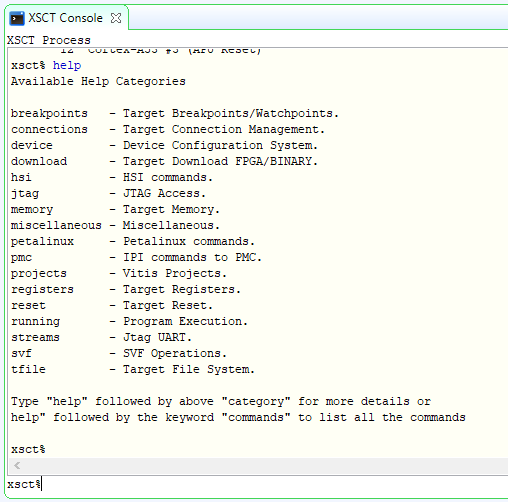
You can use the
help runningcommand to get a list of possible options for running or debugging an application using XSCT.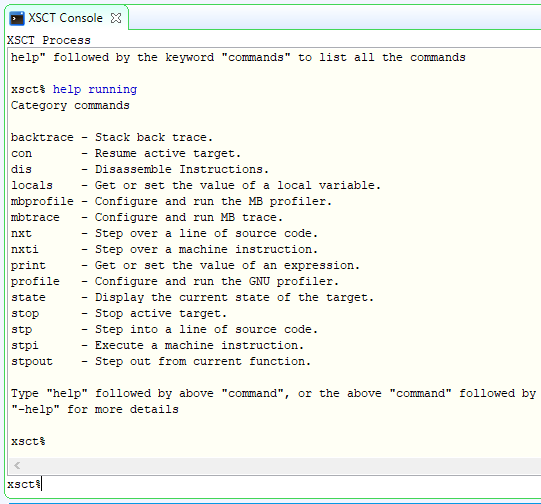
You can now run the code:
xsct% conAt this point, you can see the Cortex-R5F application print a message on the UART-1 terminal.
The next chapter shows how to build and debug Linux applications.
© Copyright 2017-2020 Xilinx, Inc.
Licensed under the Apache License, Version 2.0 (the “License”); you may not use this file except in compliance with the License. You may obtain a copy of the License at
http://www.apache.org/licenses/LICENSE-2.0
Unless required by applicable law or agreed to in writing, software distributed under the License is distributed on an “AS IS” BASIS, WITHOUT WARRANTIES OR CONDITIONS OF ANY KIND, either express or implied. See the License for the specific language governing permissions and limitations under the License.